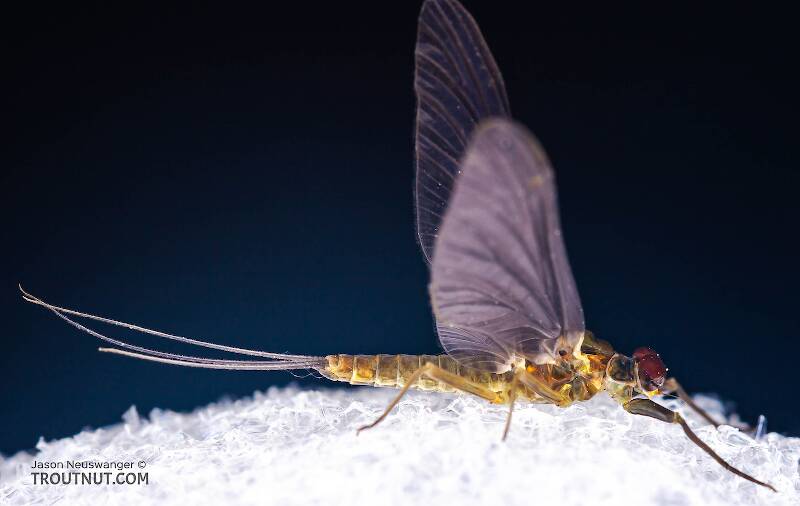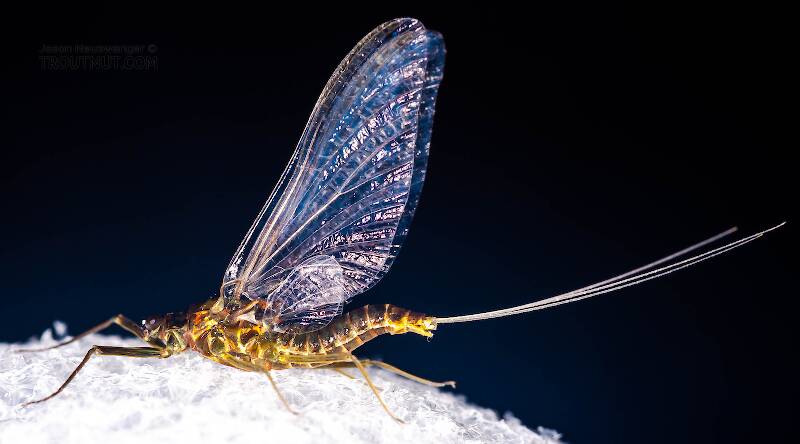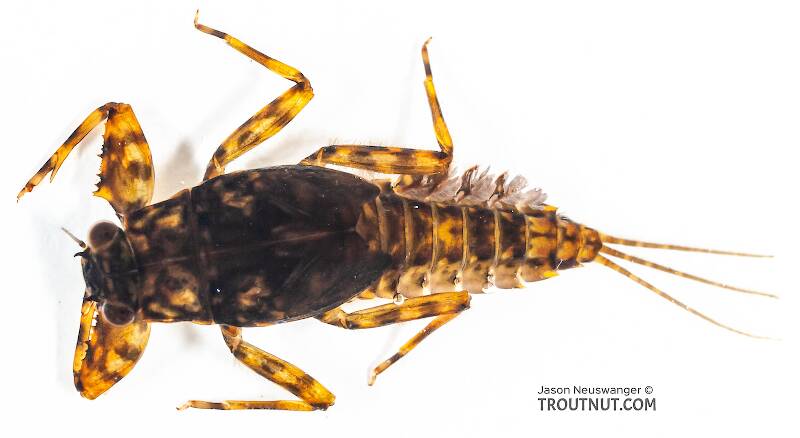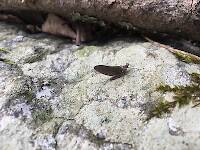
Salmonflies
Pteronarcys californica
The giant Salmonflies of the Western mountains are legendary for their proclivity to elicit consistent dry-fly action and ferocious strikes.
Featured on the forum
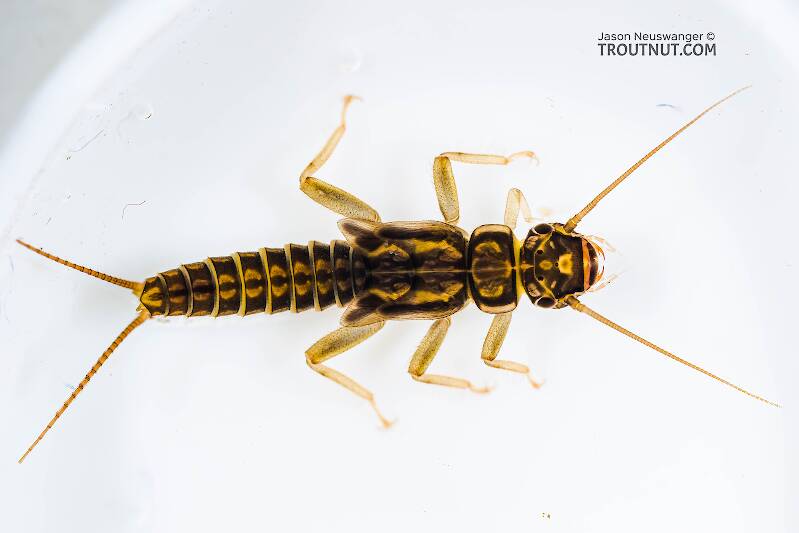

Troutnut is a project started in 2003 by salmonid ecologist Jason "Troutnut" Neuswanger to help anglers and
fly tyers unabashedly embrace the entomological side of the sport. Learn more about Troutnut or
support the project for an enhanced experience here.
This topic is about the Mayfly Species Drunella cornuta
Though not as well known as the Hendrickson and Sulphur hatches of the Ephemerella genus, Drunella cornuta (Olive Morning Dun or Large Blue-Winged Olive) is nonetheless an important Eastern hatch.Lloyd Gonzales, in his book Fly-Fishing Pressured Water, notes that this attractive olive-green mayfly can provide good-to-excellent morning fishing in the faster sections of many streams. He also mentions that it can hatch in surprising numbers and usually faces less competition for the trout's attention than many of the spring or evening-emerging ephemerellids. Yet, cornuta and its sister species have largely escaped the limelight. The renowned twilight hatches of big Ephemera drakes and many other popular mayfly species command fly fisher's attention at this time of year. As the days lengthen, fishing all of the available mayfly hatches would require a pretty long day astream, so most anglers choose to focus on the late afternoon and evening activity.
Nature seems to have several recurrent color themes, and one of these is gray-winged/olive-bodied aquatic insects. Perhaps this explains why the name "Blue-Winged Olive" is often held up as the poster child for common name confusion. It has been freely applied to a multitude of mayflies in various families, genera, and species. Prior to having a well-established common name, this mayfly was referred to by Gonzales as the Olive Morning Dun. However, it has already been added to the long list of "BWOs" on many Eastern/Midwestern hatch charts.
Example specimens
Reify on Apr 21, 2014April 21st, 2014, 2:57 pm EDT
4/21/14 - Fished the Brodhead today at the last park before last bridge on PA 191 - downstream of huge riffle section so is a great tretch for this species. I didn't get there until around 1:00 PM, took a nap and started fishing at 2:00 and there were still cornuta coming off sparsely but steadliy - until 3:30 PM. Sparse rises, but I was entertained. Is that normal or could it be because the water is unusually cold this year. Are the males and females of the same size or is one larger - and of slightly more pale coloration at take-off from surface? It almost looked to me to be two different flies, but I'm sure they weren't.
Wbranch on Apr 21, 2014April 21st, 2014, 6:56 pm EDT
Are you very confident it was cornuta? Friends were there on Saturday and saw good numbers of Ep plurealis (Quill Gordons) In my experience in the NE PA and Catskills cornuta emerges much later in the season. I've never seen it before late May. Maybe you were seeing some Baetis? What size were the bugs?
Catskill fly fisher for fifty-five years.
Entoman on Apr 22, 2014April 22nd, 2014, 4:07 am EDT
Hi Reify -
Anything is possible I suppose but as Matt says, the Morning Olive Dun (Gonzo) is normally seen much later in the season. It usually goes unnoticed becaue of hatching in the morning when most anglers are sleeping in from their late night pursuit of trout feeding on the big drakes that are also found at that time of year.
Anything is possible I suppose but as Matt says, the Morning Olive Dun (Gonzo) is normally seen much later in the season. It usually goes unnoticed becaue of hatching in the morning when most anglers are sleeping in from their late night pursuit of trout feeding on the big drakes that are also found at that time of year.
"It's not that I find fishing so important, it's just that I find all other endeavors of Man equally unimportant... And not nearly as much fun!" Robert Traver, Anatomy of a Fisherman
Reify on Apr 22, 2014April 22nd, 2014, 3:01 pm EDT
My confusion now with it being a Quill Gordon is that it definitely had three rather under-accented tails; these were pale gray/whitish and on many specimins were short, almost limp-looking. The QG has only two, as far as I know and they are quite stiff and barred. Also, the wings were very deep lead-colored. As for size, I'd call it a #14, but large #14 - they were large flies and the abdomen in particular was very heavy/ rotund with the segmentations alternating pale maroon and olive on some and more uniform - the colors more approaching each other on other samples. Cornuta is known for color transitions from lighter to darker while adrift. Finally, when on a hard surface, they held their abdomens in a very much upward-arching toward the posterior position. The Quill Gordons I've seen hatching had a darker abdomen in general, lighter-colored wings and the segmentations ran from less apparent to obvious (I carry some with both the lesser and greater amount of barring). To clarify, I'm not a hugely experienced Catskill Mayfly fisherman. I fish mostly in the Lehigh Valley where we lost so many of our mayflies long ago. I'm nearing retirement and hope to travel to and fish the upper Delaware, Beaverkill, Willowemoc, etc. as time allows. I hope to see and learn about what's left of all I've read about over my 50 years of dabbling in the art.
JOHNW on Apr 22, 2014April 22nd, 2014, 4:55 pm EDT
I am going to second the subvaria vote. Given the prevailing weather patterns it is still a little early for rotundas (they usually coincide with with the second to third rounds of the Stanley cup playoffs on your LV streams and maybe a week later in the Poconos).
The Broadheads is not an overly rich stream so colors tend to be a little muted. Subvaria is also known for color variation between genders (Hendricksons vs Red Quill) as well as in individuals as they "age" after emergence often starting almost bright pink and quickly fading to the above described gray/tan/olive almalgamation.
That and.70 $ still won't yet you a cup of coffee.
JW
The Broadheads is not an overly rich stream so colors tend to be a little muted. Subvaria is also known for color variation between genders (Hendricksons vs Red Quill) as well as in individuals as they "age" after emergence often starting almost bright pink and quickly fading to the above described gray/tan/olive almalgamation.
That and.70 $ still won't yet you a cup of coffee.
JW
"old habits are hard to kill once you have gray in your beard" -Old Red Barn
Martinlf on Apr 23, 2014April 23rd, 2014, 7:44 pm EDT
Subvaria also vary a great deal in color from stream to stream. Females are typically larger and lighter than males. It seems the most likely ID. A buddy who fishes the Brodhead told me tonight that subvaria were hatching there.
"He spread them a yard and a half. 'And every one that got away is this big.'"
--Fred Chappell
--Fred Chappell
JOHNW on Apr 24, 2014April 24th, 2014, 12:34 pm EDT
Mack,
Being a Flyers fan the observation occured because the rotundas are typically the poultice for the broken heart of a hockey fan whose team just got eliminated. ;)
The "grail date" for rotundas in that part of PA is typically May 15 while the Hendricksons tend toward mid to late April (late March in really mild winters). Since or spring tends to be a little more gradual the hatches are a little more spread out than in northern climes. There are times where there is a week or two gap between the "early dark mayflies" and the "late light mayflies". Well at least in my humble observations.
JW
Being a Flyers fan the observation occured because the rotundas are typically the poultice for the broken heart of a hockey fan whose team just got eliminated. ;)
The "grail date" for rotundas in that part of PA is typically May 15 while the Hendricksons tend toward mid to late April (late March in really mild winters). Since or spring tends to be a little more gradual the hatches are a little more spread out than in northern climes. There are times where there is a week or two gap between the "early dark mayflies" and the "late light mayflies". Well at least in my humble observations.
JW
"old habits are hard to kill once you have gray in your beard" -Old Red Barn
Quick Reply
Related Discussions
Topic
Replies
Last Reply
4
May 24, 2008
by Softhackle
by Softhackle
2
Oct 26, 2008
by Troutnut
by Troutnut
2
Nov 4, 2012
by Aszat
by Aszat


